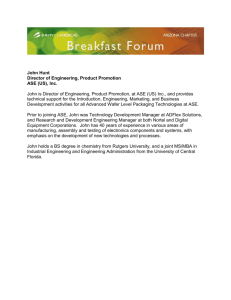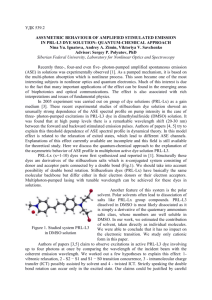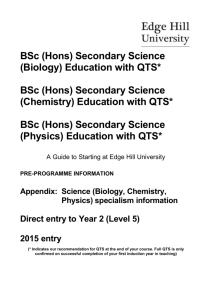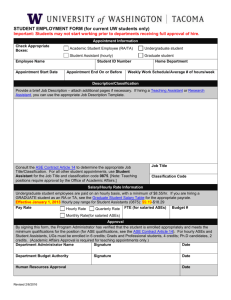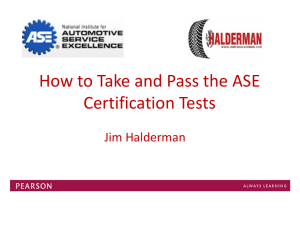Notes Pages - Appalachian State University
advertisement
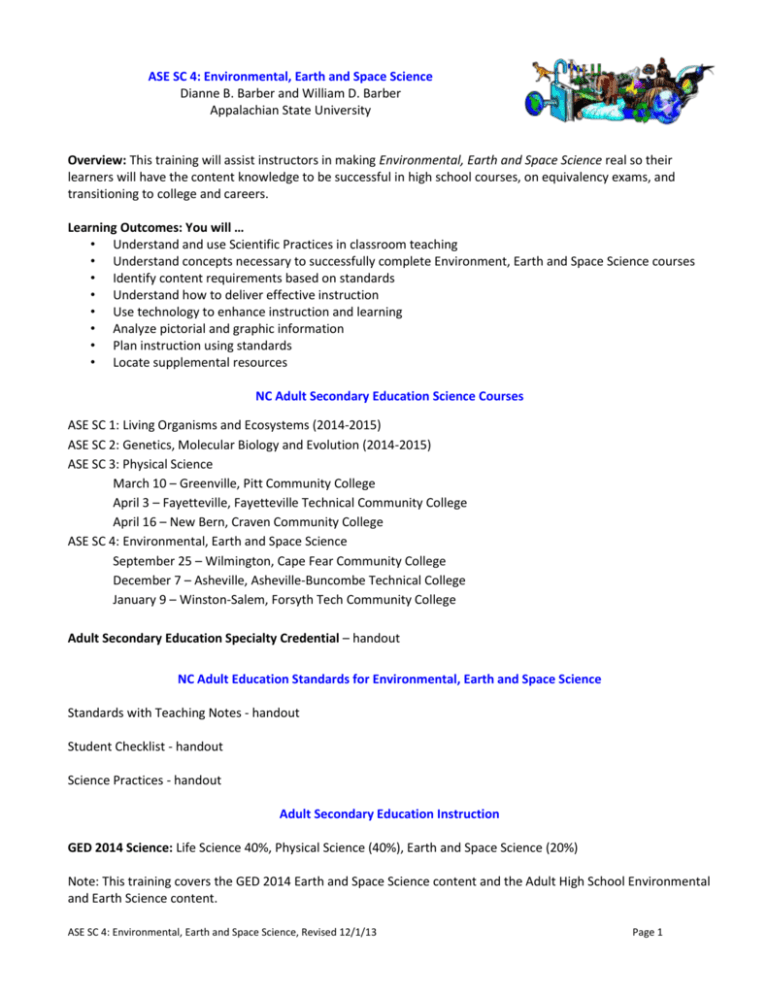
ASE SC 4: Environmental, Earth and Space Science Dianne B. Barber and William D. Barber Appalachian State University Overview: This training will assist instructors in making Environmental, Earth and Space Science real so their learners will have the content knowledge to be successful in high school courses, on equivalency exams, and transitioning to college and careers. Learning Outcomes: You will … • Understand and use Scientific Practices in classroom teaching • Understand concepts necessary to successfully complete Environment, Earth and Space Science courses • Identify content requirements based on standards • Understand how to deliver effective instruction • Use technology to enhance instruction and learning • Analyze pictorial and graphic information • Plan instruction using standards • Locate supplemental resources NC Adult Secondary Education Science Courses ASE SC 1: Living Organisms and Ecosystems (2014-2015) ASE SC 2: Genetics, Molecular Biology and Evolution (2014-2015) ASE SC 3: Physical Science March 10 – Greenville, Pitt Community College April 3 – Fayetteville, Fayetteville Technical Community College April 16 – New Bern, Craven Community College ASE SC 4: Environmental, Earth and Space Science September 25 – Wilmington, Cape Fear Community College December 7 – Asheville, Asheville-Buncombe Technical College January 9 – Winston-Salem, Forsyth Tech Community College Adult Secondary Education Specialty Credential – handout NC Adult Education Standards for Environmental, Earth and Space Science Standards with Teaching Notes - handout Student Checklist - handout Science Practices - handout Adult Secondary Education Instruction GED 2014 Science: Life Science 40%, Physical Science (40%), Earth and Space Science (20%) Note: This training covers the GED 2014 Earth and Space Science content and the Adult High School Environmental and Earth Science content. ASE SC 4: Environmental, Earth and Space Science, Revised 12/1/13 Page 1 GED 2014 Science Item Types Multiple Choice Fill-in-the-blank items Drag-and-Drop Hot spots 2 Short answer responses 1.25 hours GED 2014 Focusing Themes Science Content Topic Focusing Themes Human Health and Living Systems • Interactions between Earth’s systems and living things Energy and Related Systems • • Earth and its system components and interactions Structures and organization of the cosmos Webb’s Depth of Knowledge - handout Outdated Trends: Open-entry/exit, Teaching to the test Lab instruction and tutoring only Academic emphasis New Trends: Managed enrollment Teaching for real life Large and small group instruction Contextualized instruction Instruction • Direct and explicit Instruction • Teach vocabulary - pronunciation and meaning • Contextualize - connect your instruction to real life, careers, and college • Teach about college pathways requiring knowledge of science – What is offered in your community college or nearby community college? • Teach about careers requiring science – What jobs are in the local area? Teaching Science • Be explicit about how activities and content relate to the nature and process of science • Model scientific behaviors, strategies, language • Integrate questions such as: How do I use science? How do others use Science? How do we know this? • Use photos, videos, graphics to teach concepts • Provide time for hands-on science activities and discussion Explicit Instruction 1. Provide rational and clear explanation 2. Model the learning process 3. Guided Practice 4. Application 5. Feedback Sample AHS and GED Test Questions - handout ASE SC 4: Environmental, Earth and Space Science, Revised 12/1/13 Page 2 The Earth Sciences Geology Oceanography Meteorology Hydrology Astronomy Standard 1: Earth in the Universe In the beginning… • Evidence for Big Bang Theory includes – Cosmic microwave background – Composition of ordinary matter of Universe • Age of the Universe • Universe is expanding • How old is Earth? Earth’s Motion through Space 1. Precession – Like a spinning top with 26,000 year cycle – Has very minor effect on seasons 2. Nutation – Variation (wobble) in precession circle – Earth’s nutation period is 18.6 years (amplitude of 9.2 seconds of arc) 3. Barycenter – Earth-Moon System has a barycenter that orbits Sun – Approximately 1062 miles below Earth surface (on moon side) Earth’s Path around Milky Way Galaxy • Earth-Moon System orbits Sun (ellipitical orbit) • Solar system orbits “nucleus” of Milky Way Galaxy – Milky Way is flattened spiral disk with 2 or 3 arms • 100,000 light-years wide • 10,000 light-years thick at nucleus • Nucleus is beyond constellation Sagittarius • Universe is expanding so galaxies moving apart Earth’s Moon Theia – Earth collision – Theia was a planet about size of Mars – Dust kicked into space formed Moon – Earth crust reformed in 150 million years – Orbiting stabilized Earth’s axis of rotation ASE SC 4: Environmental, Earth and Space Science, Revised 12/1/13 Page 3 Orbits • Governed by Newtonian gravitational laws • Changed since Solar System first formed Earth’s Shape, Seasons & Tides • Earth is an oblate spheroid – • Seasons result from tilt of Earth axis – • Poles are squashed so equator bulges 26.5 miles 23.4 degrees Tides – Occur in all bodies of water – 2 high and 2 low tides every 25 hours – From gravitation pull of Moon and Sun – Spring Tide vs. Neap Tide – Diurnal, Semi-diurnal, or Mixed Sun Energy & Radiation • Sun is a star • Produces energy by atomic fusion – Hydrogen to Helium • Makes life on Earth possible • Has energy variations • Radiation varies due to solar flares ASE SC 4: Environmental, Earth and Space Science, Revised 12/1/13 Page 4 Planet Size (diameter in km) - Distance between Earth and Moon – 384,400 km 1. 2. 3. 4. Sun 1,392,000 Jupiter 139,822 Saturn (with rings) 116,464 Uranus 50,724 5. 6. 7. 8. Neptune 49,244 Earth 12,742 Venus (without gas) 12,104 Mars 6,780 9. 10. 11. 12. Ganymede (Jupiter III) 5,262 Mercury 4,879 Moon 3,474 Pluto 1,151 Standard 2: Earth’s Systems, Structures & Processes Lithosphere is affected by • Rock cycle • • • Plate tectonics – Explains earthquakes and continental history – ≈ 20 plates covering Earth move in relation to each other – Boundaries between plates classed as • Divergent: plates are moving apart • Convergent: one plate slides under another • Transform: edges of plates grind against each other Volcanoes Earthquakes ASE SC 4: Environmental, Earth and Space Science, Revised 12/1/13 Page 5 Pangaea • Breakup began about 200 mya • Separated into two continents Earth’s surface is affected by • Weathering – Breakup of rock by mechanical & chemical forces • Erosion – Water, Wind, Beach • Soil formation – – What is soil? • “Interface” suitable for plant growth • Approximately 50% water & air • Organic matter mixed with weathered rock Productive agricultural soil Earthquakes and Seismology • S waves vs. P waves – Difference in time of arrival locates “epicenter” – P waves are “push-pull” – S waves “shake” particles at right angles • • Only travel thru solid material Richter Scale is logarithmic Earthquake damage • Concrete is rigid; wood and steel flexible • Major damage if soil is wet – • Liquification causes above ground structures to sink, buried objects to float to surface Tsunami (Japanese for “harbor waves”) Determining age of the Earth • Plate tectonics has crushed most of earth’s original crustal rocks – • Still finding rocks “a bit” older Age determined by radiometric dating – So radioisotopes are our “clock in a rock” ASE SC 4: Environmental, Earth and Space Science, Revised 12/1/13 Page 6 Consequences of human activities on lithosphere Deforestation Agriculture Mining Urbanization Overgrazing Land Use Issues Methods of energy acquisition Oil Coal Natural Gas Wood Nuclear The Hydrosphere The Water Cycle Humans’ water use • Energy source - currents, heat transfer • Fresh water availability • Water quality in North Carolina Drinking water supply • Aquifers • Desalinization • Contaminants • Testing water for coliform bacteria and disease organisms ASE SC 4: Environmental, Earth and Space Science, Revised 12/1/13 Page 7 The Atmosphere • Structure and composition • Formation of typical air masses and weather systems • Cyclonic storm formation • Human activities affecting air quality Global climate • Climate cycles – Milankovitch cycles • Humans generate change • Effects on Earth’s systems What is Climate? • Long-term seasonal weather patterns • Temperature • Precipitation • Climate vs. weather • Climate may be affected by: • Latitude • Topography (mountain ranges, etc.) • Prevailing winds • Ocean currents and proximity Humans affect climate change • Burning hydrocarbons • Deforestation • Greenhouse effect ASE SC 4: Environmental, Earth and Space Science, Revised 12/1/13 Page 8 Impact of climate change • Global warming • Ocean pH • Sea level • Ozone layer • Permafrost melting The Biosphere NC biomes • Temperate Deciduous Forest • Aquatic biomes/ecosystems Forest issues • Flood prevention • Forest fires • Species diversity • Human needs NC Aquatic Biomes • Freshwater • Estuaries - “nursery” for many important species for both economy and recreation Wetlands • Salt marsh • Water pollution • Rising ocean levels • Species diversity ASE SC 4: Environmental, Earth and Space Science, Revised 12/1/13 Page 9 Living sustainably on Earth • Renewable vs. nonrenewable resources • Alternative energy technologies for NC • Sustainable agriculture and aquaculture • Effects of uncontrolled population growth • Effects of “reduce, reuse, recycle” Agricultural issues • Importance of cheap food • Loss of productive soil • Fertilizer runoff • Pesticide concerns • Monoculture Quality of life • National parks • Recreation and exercise • Roads an d transportation • Air quality • Esthetics Resources • Content Standards with Teaching Notes – Handout • GED Item Samplers: www.GEDtestingservice.com • GED Teacher Resource Center: www.newreaderspress.com/ged • NC Essential Standards Support Tools: www.dpi.state.nc.us/acre/standards/support-tools • Timed Readings: http://www.marshalladulteducation.org/index.php/reading-skills-for-todays-adult • ABSPD Website: www.abspd.appstate.edu • Dianne Barber, Director, ABSPD, barberdb@appstate.edu • William Barber, barberwd@appstate.edu ASE SC 4: Environmental, Earth and Space Science, Revised 12/1/13 Page 10
